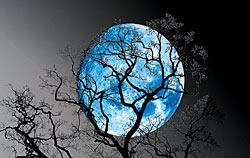 |
2009 will end with a bang as an eclipsed blue moon and the Gememid meteor shower grace the December skies. But before that, let's talk about the stars.
Orion, with his ever-ready hunting bow, will appear on the eastern horizon and herald the winter season. Along it, you will see the constellations Gemini, Taurus, Aries, Pisces, Aquarius and Capricornus. The latter three constellations are faint, and you might need a dark location to view them.
The Great Square (Pegasus) still holds ground overhead during dusk. Perseus, the savior of Andromeda, flies high in the northern skies. Look for the double cluster that marks the handle of his sword, an easy binocular target. Andromeda herself is due south and home to the great galaxy M31, the furthest object visible with the naked eye. Taurus is host to two fine open clusters, the Pleiades (Seven Sisters) and the Hyades that mark the V-shaped head of the Bull. The mighty Orion dominates the southeast.
Planet observing
Jupiter and four of its moons will be visible low in the southwest, within the constellation Capricornus, around 9pm. Jupiter's four major moons will appear as tiny specks of light arrayed along a straight line to either side of the planet.
Mars will rise in the northeast around 10pm, and will be high in the southern sky in the early hours of the morning. Mars is above Regulus, the brightest star in Leo, and well to the left of the bright star Procyon, in Canis Minor. Mars is significantly brighter than either of these two stars and is much more orange in colour.
Mercury is at its greatest distance east of the sun on 18 December. You can catch a glimpse of it on nights when it sets two hours after sunset. Look southwest immediately after sunset within a couple days before and after 22 December.
Venus will rise in the southeast just an hour before sunrise, so for the most part will be obscured by the sun's glare. It may, however, be visible very low in the dawn sky.
Saturn will rise in the east around 1am, and will be high up in the southern sky by dawn. It will be to the upper right of Spica, the brightest star in Virgo, and to the lower left of Regulus. It will also be moving very slowly south-eastwards in Virgo.
Meteors
The Gememid shower appears on 7-16 December regularly each year. It will peak around the night of 13 December, when you should see one meteor every couple of minutes. You can rest assured that visibility will be clear since there won't be any interfering moonlight this year. Watch out for the Quadrantids showers at December's end too.
Eclipsed Blue Moon
There will be a full moon within Taurus on 2 December and a 'Blue Moon' - essentially an irregularly timed full moon - within Gemini on 31 December. The Blue Moon will be partly obscured by a lunar eclipse from 12:36:26am to 1:38:37am, all of which will be visible from Nepal. The eclipse will peak at 1:07:28am at which point 8 per cent of the moon's disc will be hidden.
Wishing you all clear skies and a very Happy New Year 2010!


